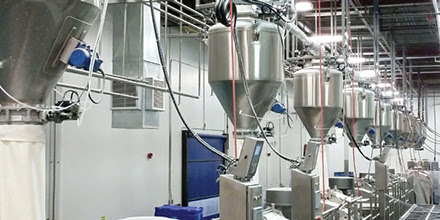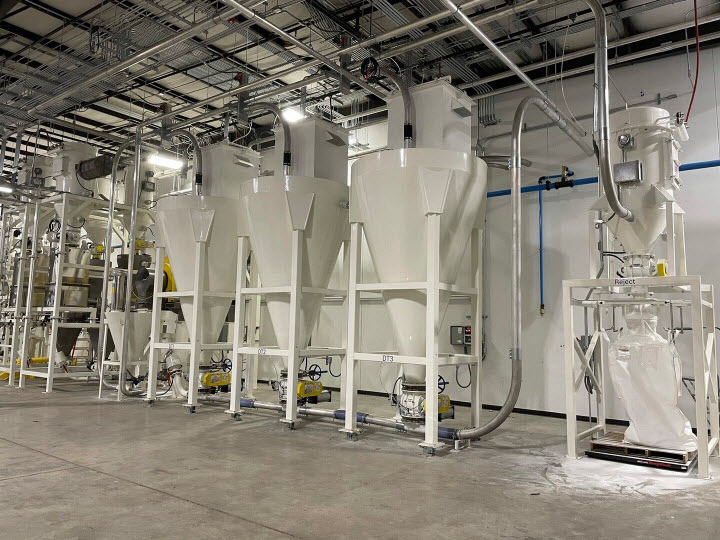Benefits of Vacuum Pneumatic Conveyors
The benefits of vacuum pneumatic conveyors extend to automated control. Aside from contributing to automated control, vacuum conveyors are used in a wide variety of applications. This means that operators should use appropriate equipment and be aware of the working environment, which can include alkalinity, humidity, and degrees of hotness and coldness. Before deciding on a vacuum conveyor, consider the needs of your supplier and the layout of your facility.
Dilute Phase Vacuum Conveyors
A dilute phase vacuum pneumatic conveying system involves a flow of air with a high pressure, usually between five and twelve inches of mercury. Materials enter the airstream at a rate of approximately 3,000 feet per minute and build up to a maximum speed of around 6,500 feet per minute. The high speed of dilute phase conveying can be problematic for some materials, such as common plastics and mineral-filled resins.
Dilute phase pneumatic conveying systems can handle materials with varying viscosities. In contrast, a dense-phase pneumatic system uses high-pressure air and can handle a variety of materials. However, it is important to note that high-pressure systems can cause wear and material degradation. Therefore, if high-velocity air is required, dilute-phase pneumatic conveying systems are a better option.

Rotary Airlock Valves
Rotary airlock valves are used for conveying liquids and solids, and maintain the appropriate pressure differential with the ambient atmosphere. Non-flowfeed rotary airlock valves are used at the pick-up points of pneumatic conveyers. These valves provide consistent, accurate metering, eliminating ambient air interference. For this reason, they are the most common choice for conveying liquids and solids.
Whether your conveyor uses positive or negative pressure systems, the rotary airlock valve will reduce the chances of air leakage. However, you must be aware of the causes of air leakage and how to prevent it. For example, processing abrasive materials can cause cumulative damage to the surfaces inside the valve. In addition, surface drag abrasion occurs when materials become trapped between moving surfaces. Another form of pneumatic abrasion occurs when turbulent air develops at the outlet port, resulting in a decrease in efficiency and abrasive particles.
Feed Station Hoppers
There are many benefits to using feed station hoppers in vacuum pneumatic conveyors. These types of hoppers can handle a variety of solid materials, from bulk to powdery materials. The type of feeding device that you will use depends on your application and material flow properties. These hoppers are used to load and unload ingredients from dusty containers. Depending on the powder being transported, you can choose from either a two or five-screw conveyor. These conveyors are ideal for this application because of their high accuracy, low maintenance and minimal energy usage. These conveyors also feature self-cleaning and are easy to install. This means that your production facility will have less waste than it would if using a standard conveyor system.

Small Footprints
One of the great advantages of a vacuum conveyor is its small footprint. These machines can be installed in any space, reducing costs by minimizing floor space. They are easy to install and self-cleaning. And, since they use a vacuum, they do not require any external energy sources. Small footprints are also a great benefit for energy-conscious companies. This article looks at some of the other benefits of vacuum pneumatic conveyors.
Aside from small footprints, vacuum conveyors offer great flexibility. This makes them suitable for moving materials with difficult to transport characteristics. These systems can also be used to move powders or granules. To make the most of their advantages, you should understand the difference between the two types. Understanding the difference between them will help you choose the right system for your requirements. A vacuum conveyor is a great choice for businesses that need a high capacity without a large footprint.
Fire Hazards
Combustible dusts and vapors present significant deflagration and fire hazards when suspended in air or vaporized. As a result, vacuum pneumatic conveying systems must be designed to minimize these risks. A combustible dust explosion can result in employee deaths and serious injuries, and it can destroy entire buildings. Because of these risks, pneumatic conveying systems are specifically designed to avoid dust explosions. These explosions result from five basic elements: oxygen, heat, fuel, and dispersion.
A major fire risk is caused by hot work equipment. This equipment generates sparks and molten materials that can easily reach a temperature of 1,000oF and travel 35 feet. This equipment may be accompanied by flammable gases and liquids. Chemical plants routinely deal with highly flammable products. As such, sparking or electrical equipment used to operate these products can ignite combustible dust and vapors, resulting in a devastating explosion.
Versatility
When it comes to conveying powder materials, vacuum conveyors are the best choice. They are easy to install and operate, and can handle a variety of materials. They also keep the production environment clean and safe. This makes them an ideal choice in industries where explosions are a serious risk. Below are some of the reasons why vacuum conveyors are the best choice. And if you’re wondering if they’re the right choice for your production line, you may want to consider this information. Bhagwati pneumatic conveyors are a proven workhorse in industrial settings. They can handle both bulk and lean phase materials.
















